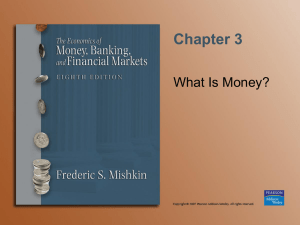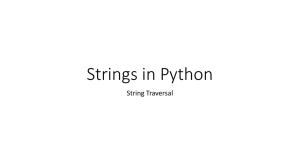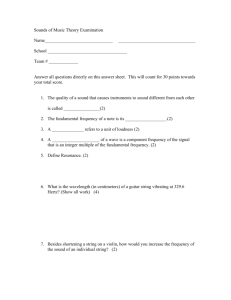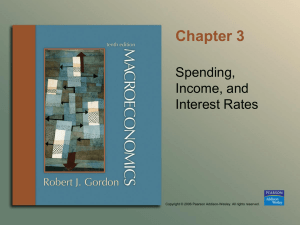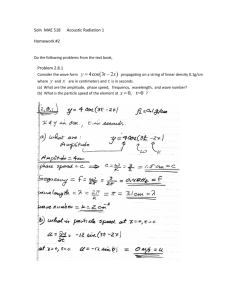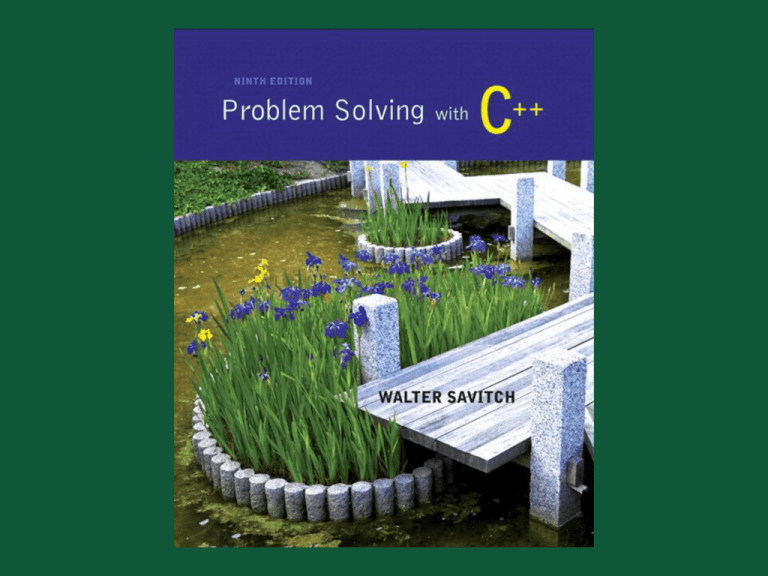
Chapter
8
Strings and Vectors
Copyright © 2014 Pearson Addison-Wesley. All rights reserved.
Overview
8.1 An Array Type for Strings
8.2 The Standard string Class
8.3 Vectors
Copyright © 2014 Pearson Addison-Wesley. All rights reserved.
Slide 8- 3
8.1
An Array Type for Strings
Copyright © 2014 Pearson Addison-Wesley. All rights reserved.
An Array Type for Strings
C-strings can be used to represent strings of
characters
C-strings are stored as arrays of characters
C-strings use the null character '\0' to end a
string
The Null character is a single character
To declare a C-string variable, declare an array
of characters:
char s[11];
Copyright © 2014 Pearson Addison-Wesley. All rights reserved.
Slide 8- 5
C-string Details
Declaring a C-string as char s[10] creates space
for only nine characters
The null character terminator requires one
space
A C-string variable does not need a size variable
The null character immediately follows the last
character of the string
Example:s[0] s[1] s[2] s[3] s[4] s[5] s[6] s[7] s[8] s[9]
H i
Copyright © 2014 Pearson Addison-Wesley. All rights reserved.
M
o
m
!
\0
?
?
Slide 8- 6
C-string Declaration
To declare a C-string variable, use the syntax:
char Array_name[ Maximum_C_String_Size + 1];
+ 1 reserves the additional character needed
by '\0'
Copyright © 2014 Pearson Addison-Wesley. All rights reserved.
Slide 8- 7
Initializing a C-string
To initialize a C-string during declaration:
char my_message[20] = "Hi there.";
The null character '\0' is added for you
Another alternative:
char short_string[ ] = "abc";
but not this:
char short_string[ ] = {'a', 'b', 'c'};
Copyright © 2014 Pearson Addison-Wesley. All rights reserved.
Slide 8- 8
C-string error
This attempt to initialize a C-string does not
cause the \0 to be inserted in the array
char short_string[ ] = {'a', 'b', 'c'};
Copyright © 2014 Pearson Addison-Wesley. All rights reserved.
Slide 8- 9
Don't Change '\0'
Do not to replace the null character when
manipulating indexed variables in a C-string
If the null character is lost, the array cannot act
like a C-string
Example: int index = 0;
while (our_string[index] != '\0')
{
our_string[index] = 'X';
index++;
}
This code depends on finding the null character!
Copyright © 2014 Pearson Addison-Wesley. All rights reserved.
Slide 8- 10
Safer Processing of C-strings
The loop on the previous slide depended on
finding the '\0' character
It would be wiser to use this version in case the
'\0' character had been removed
int index = 0;
while (our_string[index] != '\0'
&& index < SIZE)
{
our_string[index] = 'X';
index++;
}
Copyright © 2014 Pearson Addison-Wesley. All rights reserved.
Slide 8- 11
Assignment With C-strings
This statement is illegal:
a_string = "Hello";
This is an assignment statement, not an
initialization
The assignment operator does not work with
C-strings
Copyright © 2014 Pearson Addison-Wesley. All rights reserved.
Slide 8- 12
Assignment of C-strings
A common method to assign a value to a
C-string variable is to use strcpy, defined in
the cstring library
Example:
#include <cstring>
…
char a_string[ 11];
strcpy (a_string, "Hello");
Places "Hello" followed by the null character in
a_string
Copyright © 2014 Pearson Addison-Wesley. All rights reserved.
Slide 8- 13
A Problem With strcpy
strcpy can create problems if not used carefully
strcpy does not check the declared length of
the first argument
It is possible for strcpy to write characters
beyond the declared size of the array
Copyright © 2014 Pearson Addison-Wesley. All rights reserved.
Slide 8- 14
A Solution for strcpy
Many versions of C++ have a safer version of
strcpy named strncpy
strncpy uses a third argument representing the
maximum number of characters to copy
Example:
char another_string[10];
strncpy(another_string,
a_string_variable, 9);
This code copies up to 9 characters into
another_string, leaving one space for '\0'
Copyright © 2014 Pearson Addison-Wesley. All rights reserved.
Slide 8- 15
== Alternative for C-strings
The == operator does not work as expected with
C-strings
The predefined function strcmp is used to compare Cstring variables
Example:
#include <cstring>
…
if (strcmp(c_string1, c_string2))
cout << "Strings are not the same.";
else
cout << "String are the same.";
Copyright © 2014 Pearson Addison-Wesley. All rights reserved.
Slide 8- 16
strcmp's logic
strcmp compares the numeric codes of elements
in the C-strings a character at a time
If the two C-strings are the same, strcmp
returns 0
0 is interpreted as false
As soon as the characters do not match
strcmp returns a negative value if the numeric code
in the first parameter is less
strcmp returns a positive value if the numeric code
in the second parameter is less
Non-zero values are interpreted as true
Copyright © 2014 Pearson Addison-Wesley. All rights reserved.
Slide 8- 17
More C-string Functions
The cstring library includes other functions
strlen returns the number of characters in a string
int x = strlen( a_string);
strcat concatenates two C-strings
The second argument is added to the end of the
first
The result is placed in the first argument
Example:
char string_var[20] = "The rain";
strcat(string_var, "in Spain");
Now string_var contains "The rainin Spain"
Copyright © 2014 Pearson Addison-Wesley. All rights reserved.
Slide 8- 18
The strncat Function
strncat is a safer version of strcat
A third parameter specifies a limit for the
number of characters to concatenate
Example:
char string_var[20] = "The rain";
strncat(string_var, "in Spain", 11);
Display 8.1 (1)
Display 8.1 (2)
Copyright © 2014 Pearson Addison-Wesley. All rights reserved.
Slide 8- 19
C-strings as
Arguments and Parameters
C-string variables are arrays
C-string arguments and parameters are used just
like arrays
If a function changes the value of a C-string
parameter, it is best to include a parameter for
the declared size of the C-string
If a function does not change the value of a
C-string parameter, the null character can
detect the end of the string and no size
argument is needed
Copyright © 2014 Pearson Addison-Wesley. All rights reserved.
Slide 8- 20
C-string Output
C-strings can be output with the insertion
operator
Example:
char news[ ] = "C-strings";
cout << news << " Wow."
<< endl;
Copyright © 2014 Pearson Addison-Wesley. All rights reserved.
Slide 8- 21
C-string Input
The extraction operator >> can fill a C-string
Whitespace ends reading of data
Example:
char a[80], b[80];
cout << "Enter input: " << endl;
cin >> a >> b;
cout << a << b << "End of Output";
could produce:
Enter input:
Do be do to you!
DobeEnd of Output
Copyright © 2014 Pearson Addison-Wesley. All rights reserved.
Slide 8- 22
Reading an Entire Line
Predefined member function getline can read an
entire line, including spaces
getline is a member of all input streams
getline has two arguments
The first is a C-string variable to receive input
The second is an integer, usually the size of the first
argument specifying the maximum number of
elements in the first argument getline is allowed to
fill
Copyright © 2014 Pearson Addison-Wesley. All rights reserved.
Slide 8- 23
Using getline
The following code is used to read an entire line
including spaces into a single C-string variable
char a[80];
cout << "Enter input:\n";
cin.getline(a, 80);
cout << a << End Of Output\n";
and could produce:
Enter some input:
Do be do to you!
Do be do to you!End of Output
Copyright © 2014 Pearson Addison-Wesley. All rights reserved.
Slide 8- 24
getline wrap up
getline stops reading when the number of
characters, less one, specified in the second
argument have been placed in the C-string
one character is reserved for the null character
getline stops even if the end of the line has not
been reached
Copyright © 2014 Pearson Addison-Wesley. All rights reserved.
Slide 8- 25
getline and Files
C-string input and output work the same way
with file streams
Replace cin with the name of an input-file
stream
in_stream >> c_string;
in_stream.getline(c_string, 80);
Replace cout with the name of an output-file
stream
out_stream << c_string;
Copyright © 2014 Pearson Addison-Wesley. All rights reserved.
Slide 8- 26
getline syntax
Syntax for using getline is
cin.getline(String_Var, Max_Characters + 1);
cin can be replaced by any input stream
Max_Characters + 1 reserves one element for
the null character
Copyright © 2014 Pearson Addison-Wesley. All rights reserved.
Slide 8- 27
C-String to Numbers
"1234" is a string of characters
1234 is a number
When doing numeric input, it is useful to read
input as a string of characters, then convert
the string to a number
Reading money may involve a dollar sign
Reading percentages may involve a percent
sign
Copyright © 2014 Pearson Addison-Wesley. All rights reserved.
Slide 8- 28
C-strings to Integers
To read an integer as characters
Read input as characters into a C-string,
removing unwanted characters
Use the predefined function atoi to convert the
C-string to an int value
Example:
atoi("1234") returns the integer 1234
atoi("#123") returns 0 because # is not
a digit
Copyright © 2014 Pearson Addison-Wesley. All rights reserved.
Slide 8- 29
C-string to long
Larger integers can be converted using the
predefined function atol
atol returns a value of type long
Copyright © 2014 Pearson Addison-Wesley. All rights reserved.
Slide 8- 30
C-string to double
C-strings can be converted to type double using
the predefined function atof
atof returns a value of type double
Example:
atof("9.99") returns 9.99
atof("$9.99") returns 0.0 because the
$ is not a digit
Copyright © 2014 Pearson Addison-Wesley. All rights reserved.
Slide 8- 31
Library cstdlib
The conversion functions
atoi
atol
atof
are found in the library cstdlib
To use the functions use the include directive
#include <cstdlib>
Copyright © 2014 Pearson Addison-Wesley. All rights reserved.
Slide 8- 32
Numeric Input
We now know how to convert C-strings to
numbers
How do we read the input?
Function read_and_clean, in Display 8.2…
Reads a line of input
Discards all characters other than the digits '0'
through '9'
Uses atoi to convert the "cleaned-up" C-string to int
Display 8.2 (1)
Display 8.2 (2)
Copyright © 2014 Pearson Addison-Wesley. All rights reserved.
Slide 8- 33
Confirming Input
Function get_int, from Display 8.3…
Uses read_and_clean to read the user's input
Allows the user to reenter the input until the
user is satisfied with the number computed
from the input string
Display 8.3 (1)
Display 8.3 (2)
Copyright © 2014 Pearson Addison-Wesley. All rights reserved.
Slide 8- 34
Section 8.1 Conclusion
Can you
Describe the benefits of reading numeric data
as characters before converting the characters
to a number?
Write code to do input and output with
C-strings?
Use the atoi, atol, and atof functions?
Identify the character that ends a C-string?
Copyright © 2014 Pearson Addison-Wesley. All rights reserved.
Slide 8- 35
8.2
The Standard string Class
Copyright © 2014 Pearson Addison-Wesley. All rights reserved.
The Standard string Class
The string class allows the programmer to treat
strings as a basic data type
No need to deal with the implementation as
with C-strings
The string class is defined in the string library
and the names are in the standard namespace
To use the string class you need these lines:
#include <string>
using namespace std;
Copyright © 2014 Pearson Addison-Wesley. All rights reserved.
Slide 8- 37
Assignment of Strings
Variables of type string can be assigned with
the = operator
Example:
string s1, s2, s3;
…
s3 = s2;
Quoted strings are type cast to type string
Example:
string s1 = "Hello Mom!";
Copyright © 2014 Pearson Addison-Wesley. All rights reserved.
Slide 8- 38
Using + With strings
Variables of type string can be concatenated
with the + operator
Example:
string s1, s2, s3;
…
s3 = s1 + s2;
If s3 is not large enough to contain s1 + s2,
more space is allocated
Copyright © 2014 Pearson Addison-Wesley. All rights reserved.
Slide 8- 39
string Constructors
The default string constructor initializes the
string to the empty string
Another string constructor takes a C-string
argument
Example:
string phrase;
// empty string
string noun("ants"); // a string version
// of "ants"
Copyright © 2014 Pearson Addison-Wesley. All rights reserved.
Slide 8- 40
Mixing strings and C-strings
It is natural to work with strings in the following
manner
string phrase = "I love" + adjective + " "
+ noun + "!";
It is not so easy for C++! It must either convert
the null-terminated C-strings, such as "I love",
to strings, or it must use an overloaded +
operator that works
Display 8.4
with strings and C-strings
Copyright © 2014 Pearson Addison-Wesley. All rights reserved.
Slide 8- 41
I/O With Class string
The insertion operator << is used to output
objects of type string
Example:
string s = "Hello Mom!";
cout << s;
The extraction operator >> can be used to input
data for objects of type string
Example:
string s1;
cin >> s1;
>> skips whitespace and stops on encountering
more whitespace
Copyright © 2014 Pearson Addison-Wesley. All rights reserved.
Slide 8- 42
getline and Type string
A getline function exists to read entire lines into
a string variable
This version of getline is not a member of the
istream class, it is a non-member function
Syntax for using this getline is different than
that used with cin: cin.getline(…)
Syntax for using getline with string objects:
getline(Istream_Object, String_Object);
Copyright © 2014 Pearson Addison-Wesley. All rights reserved.
Slide 8- 43
getline Example
This code demonstrates the use of getline with
string objects
string line;
cout "Enter a line of input:\n";
getline(cin, line);
cout << line << "END OF OUTPUT\n";
Output could be:
Enter some input:
Do be do to you!
Do be do to you!END OF OUTPUT
Copyright © 2014 Pearson Addison-Wesley. All rights reserved.
Slide 8- 44
Character Input With strings
The extraction operator cannot be used to read
a blank character
To read one character at a time remember to
use cin.get
cin.get reads values of type char, not type
string
The use of getline, and cin.get for string input are
demonstrated in
Display 8.5 (1)
Display 8.5 (2)
Copyright © 2014 Pearson Addison-Wesley. All rights reserved.
Slide 8- 45
Another Version of getline
The versions of getline we have seen, stop
reading at the end of line marker '\n'
getline can stop reading at a character specified
in the argument list
This code stops reading when a '?' is read
string line;
cout <<"Enter some input: \n";
getline(cin, line, '?');
Copyright © 2014 Pearson Addison-Wesley. All rights reserved.
Slide 8- 46
getline Returns a Reference
getline returns a reference to its first argument
This code will read in a line of text into s1 and
a string of non-whitespace characters into s2:
string s1, s2;
getline(cin, s1) >> s2;
returns
cin >> s2;
Copyright © 2014 Pearson Addison-Wesley. All rights reserved.
Slide 8- 47
getline Declarations
These are the declarations of the versions of
getline for string objects we have seen
istream& getline(istream& ins, string& str_var,
char delimiter);
istream& getline(istream& ins, string& str_var);
Copyright © 2014 Pearson Addison-Wesley. All rights reserved.
Slide 8- 48
Mixing cin >> and getline
Recall cin >> n skips whitespace to find what it
is to read then stops reading when whitespace
is found
cin >> leaves the '\n' character in the input stream
Example:
int n;
string line;
cin >> n;
getline(cin, line);
leaves the '\n' which immediately ends getline's
reading…line is set equal to the empty string
Copyright © 2014 Pearson Addison-Wesley. All rights reserved.
Slide 8- 49
ignore
ignore is a member of the istream class
ignore can be used to read and discard all the
characters, including '\n' that remain in a line
Ignore takes two arguments
First, the maximum number of characters to discard
Second, the character that stops reading and
discarding
Example: cin.ignore(1000, '\n');
reads up to 1000 characters or to '\n'
Copyright © 2014 Pearson Addison-Wesley. All rights reserved.
Slide 8- 50
String Processing
The string class allows the same operations we
used with C-strings…and more
Characters in a string object can be accessed
as if they are in an array
last_name[i] provides access to a single character
as in an array
Index values are not checked for validity!
Display 8.6
Copyright © 2014 Pearson Addison-Wesley. All rights reserved.
Slide 8- 51
Member Function length
The string class member function length returns
the number of characters in the string object:
Example:
int n = string_var.length( );
Copyright © 2014 Pearson Addison-Wesley. All rights reserved.
Slide 8- 52
Member Function at
at is an alternative to using [ ]'s to access
characters in a string.
at checks for valid index values
Example:
string str("Mary");
Equivalent
cout << str[6] << endl;
cout << str.at(6) << endl;
Equivalent
str[2] = 'X';
str.at(2) = 'X';
Other string class functions are found in
Copyright © 2014 Pearson Addison-Wesley. All rights reserved.
Display 8.7
Slide 8- 53
string class to numbers
C++11 has new functions to convert a string class
object to a number
int i;
double d;
string s;
i = stoi("35"); // Converts the string "35" to an integer 35
d = stod("2.5"); // Converts the string "2.5" to the double 2.5
C++11 has new functions to convert a string class
object to a number
string s = to_string(1.2*2); // “2.4” stored in s
Copyright © 2014 Pearson Addison-Wesley. All rights reserved.
Slide 1- 54
Comparison of strings
Comparison operators work with string objects
Objects are compared using lexicographic
order (Alphabetical ordering using the order of
symbols in the ASCII character set.)
== returns true if two string objects contain
the same characters in the same order
Remember strcmp for C-strings?
<, >, <=, >= can be used to compare string
objects
Copyright © 2014 Pearson Addison-Wesley. All rights reserved.
Slide 8- 55
Program Example:
Palindrome Testing
A palindrome is a string that reads the same
from front to back as it does from back to front
This program ignores spaces and punctuation
Upper and lowercase versions of letters are
considered the same letter
Examples:
Able was I 'ere I saw Elba.
Madam, I'm Adam.
A man, a plan, a canal, Panama.
Racecar
Copyright © 2014 Pearson Addison-Wesley. All rights reserved.
Slide 8- 56
Palindrome Testing:
remove_punct
remove_punct removes punctuation from a string
remove_punct compares each character in the
string to the characters in a string containing all
the punctuation characters and the space
character.
If a match is not found, the character is added
to the string no_punct
no_punct, the original string less any
punctuation or spaces, is returned
Copyright © 2014 Pearson Addison-Wesley. All rights reserved.
Slide 8- 57
Palindrome Testing:
substr
The substr member function is used to locate
a substring within a string
remove_punct uses substr to extract a single
character at a time from the source string. The
character is stored in a_char.
remove_punct then uses function find to see if
the character in a_char is in the string of
punctuation characters
Copyright © 2014 Pearson Addison-Wesley. All rights reserved.
Slide 8- 58
Palindrome Testing:
The Program
The entire palindrome testing program is
found in
Display 8.8 (1)
Display 8.8 (2)
Display 8.8 (3)
Display 8.8 (4)
Copyright © 2014 Pearson Addison-Wesley. All rights reserved.
Slide 8- 59
string Objects to C-strings
Recall the automatic conversion from C-string
to string: char a_c_string[] = "C-string";
string_variable = a_c_string;
strings are not converted to C-strings
Both of these statements are illegal:
a_c_string = string_variable;
strcpy(a_c_string, string_variable);
Copyright © 2014 Pearson Addison-Wesley. All rights reserved.
Slide 8- 60
Converting strings to C-strings
The string class member function c_str returns
the C-string version of a string object
Example:
strcpy(a_c_string, string_variable.c_str( ) );
This line is still illegal
a_c_string = string_variable.c_str( ) ;
Recall that operator = does not work with Cstrings
Copyright © 2014 Pearson Addison-Wesley. All rights reserved.
Slide 8- 61
Section 8.2 Conclusion
Can you
Show how a string object can be used like a
C-string?
Write code to read an entire line into a string
object?
Use the string function at to access individual
characters in a string object?
Write code to convert a string to a C-string?
Copyright © 2014 Pearson Addison-Wesley. All rights reserved.
Slide 8- 62
8.3
Vectors
Copyright © 2014 Pearson Addison-Wesley. All rights reserved.
Vectors
Vectors are like arrays that can change size as
your program runs
Vectors, like arrays, have a base type
To declare an empty vector with base type int:
vector<int> v;
<int> identifies vector as a template class
You can use any base type in a template class:
vector<string> v;
Copyright © 2014 Pearson Addison-Wesley. All rights reserved.
Slide 8- 64
Accessing vector Elements
Vectors elements are indexed starting with 0
[ ]'s are used to read or change the value of an
item:
v[i] = 42;
cout << v[i];
[ ]'s cannot be used to initialize a vector
element
Copyright © 2014 Pearson Addison-Wesley. All rights reserved.
Slide 8- 65
Initializing vector Elements
Elements are added to a vector using the
member function push_back
push_back adds an element in the next
available position
Example:
vector<double> sample;
sample.push_back(0.0);
sample.push_back(1.1);
sample.push_back(2.2);
Copyright © 2014 Pearson Addison-Wesley. All rights reserved.
Slide 8- 66
The size Of A vector
The member function size returns the number
of elements in a vector
Example: To print each element of a vector
given the previous vector initialization:
for (int i= 0; i < sample.size( ); i++)
cout << sample[i] << endl;
Copyright © 2014 Pearson Addison-Wesley. All rights reserved.
Slide 8- 67
The Type unsigned int
The vector class member function size returns
an unsigned int
Unsigned int's are nonnegative integers
Some compilers will give a warning if the
previous for-loop is not changed to:
for (unsigned int i= 0; i < sample.size( ); i++)
cout << sample[i] << endl;
Copyright © 2014 Pearson Addison-Wesley. All rights reserved.
Slide 8- 68
Alternate vector Initialization
A vector constructor exists that takes an
integer argument and initializes that number of
elements
Example:
vector<int> v(10);
initializes the first 10 elements to 0
v.size( ) would return 10
[ ]'s can now be used to assign elements 0 through 9
push_back is used to assign elements greater than 9
Copyright © 2014 Pearson Addison-Wesley. All rights reserved.
Slide 8- 69
Vector Initialization
With Classes
The vector constructor with an integer argument
Initializes elements of number types to zero
Initializes elements of class types using the
default constructor for the class
Copyright © 2014 Pearson Addison-Wesley. All rights reserved.
Slide 8- 70
The vector Library
To use the vector class
Include the vector library
#include <vector>
Vector names are placed in the standard
namespace so the usual using directive is
needed:
using namespace std;
Copyright © 2014 Pearson Addison-Wesley. All rights reserved.
Display 8.9
Slide 8- 71
vector Issues
Attempting to use [ ] to set a value beyond the
size of a vector may not generate an error
The program will probably misbehave
The assignment operator with vectors does an
element by element copy of the right hand vector
For class types, the assignment operator must
make independent copies
Copyright © 2014 Pearson Addison-Wesley. All rights reserved.
Slide 8- 72
vector Efficiency
A vector's capacity is the number of elements
allocated in memory
Accessible using the capacity( ) member function
Size is the number of elements initialized
When a vector runs out of space, the capacity is
automatically increased
A common scheme is to double the size of a
vector
More efficient than allocating smaller chunks of
memory
Copyright © 2014 Pearson Addison-Wesley. All rights reserved.
Slide 8- 73
Controlling vector Capacity
When efficiency is an issue
Member function reserve can increase the
capacity of a vector
Example:
v.reserve(32); // at least 32 elements
v.reserve(v.size( ) + 10); // at least 10 more
resize can be used to shrink a vector
Example:
v.resize(24);
//elements beyond 24 are lost
Copyright © 2014 Pearson Addison-Wesley. All rights reserved.
Slide 8- 74
Section 8.3 Conclusion
Can you
Declare and initialize a vector of 10 doubles?
Write code to increase the size of a vector in at
least two different ways?
Describe the difference between a vector's size
and its capacity?
Copyright © 2014 Pearson Addison-Wesley. All rights reserved.
Slide 8- 75
Chapter 8 -- End
Copyright © 2014 Pearson Addison-Wesley. All rights reserved.
Slide 8- 76
Display 8.1
(1/2)
Copyright © 2014 Pearson Addison-Wesley. All rights reserved.
Back
Next
Slide 8- 77
Display 8.1
(2/2)
Copyright © 2014 Pearson Addison-Wesley. All rights reserved.
Back
Next
Slide 8- 78
Display 8.2
(1/2)
Copyright © 2014 Pearson Addison-Wesley. All rights reserved.
Back
Next
Slide 8- 79
Display 8.2 (2/2)
Back
Copyright © 2014 Pearson Addison-Wesley. All rights reserved.
Next
Slide 8- 80
Display 8.3
(1/3)
Copyright © 2014 Pearson Addison-Wesley. All rights reserved.
Back
Next
Slide 8- 81
Display 8.3 (2/3)
Back
Copyright © 2014 Pearson Addison-Wesley. All rights reserved.
Next
Slide 8- 82
Display 8.3
(3/3)
Copyright © 2014 Pearson Addison-Wesley. All rights reserved.
Back
Next
Slide 8- 83
Display 8.4
Copyright © 2014 Pearson Addison-Wesley. All rights reserved.
Back
Next
Slide 8- 84
Display 8.5 (1/2)
Back
Copyright © 2014 Pearson Addison-Wesley. All rights reserved.
Next
Slide 8- 85
Display 8.5
(2/2)
Copyright © 2014 Pearson Addison-Wesley. All rights reserved.
Back
Next
Slide 8- 86
Display 8.6
Back
Copyright © 2014 Pearson Addison-Wesley. All rights reserved.
Next
Slide 8- 87
Display 8.7
Back
Copyright © 2014 Pearson Addison-Wesley. All rights reserved.
Next
Slide 8- 88
Display 8.8 (1/4)
Back
Copyright © 2014 Pearson Addison-Wesley. All rights reserved.
Next
Slide 8- 89
Display 8.8 (2/4)
Back
Copyright © 2014 Pearson Addison-Wesley. All rights reserved.
Next
Slide 8- 90
Display 8.8
(3/4)
Copyright © 2014 Pearson Addison-Wesley. All rights reserved.
Back
Next
Slide 8- 91
Display 8.8
(4/4)
Copyright © 2014 Pearson Addison-Wesley. All rights reserved.
Back
Next
Slide 8- 92
Display 8.9
Back
Copyright © 2014 Pearson Addison-Wesley. All rights reserved.
Next
Slide 8- 93

